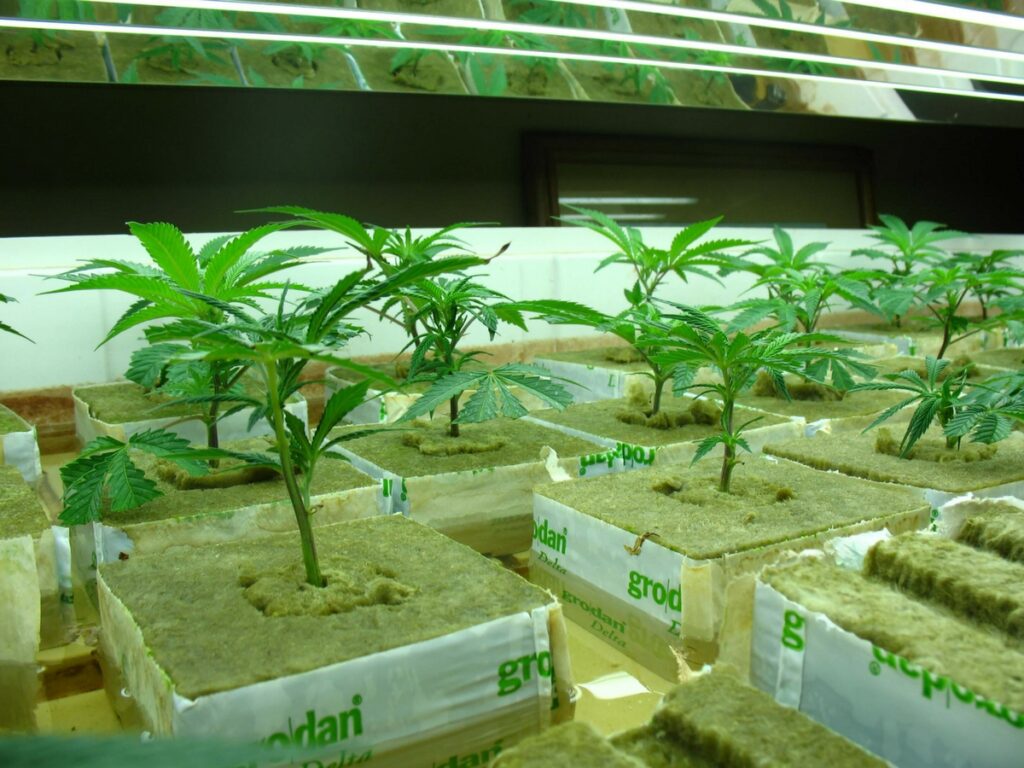
Choices for lamps
We prefer high-pressure sodium lamps, and mercury-iodide lamps for illumination. Ordinary light bulbs are not suited for cannabis-growing due to their considerably short life span, and principally due to their low light yield. Halogen lamps are not advisable for the same reasons. Fluorescent lamps are not appropriate for home growing. They do serve well, however, to stimulate seedlings and cuttings to set root. For actual growing, we stick to gas discharge lamps in the form of high-pressure- sodium, and mercury-iodide lamps. There are lamps being sold which emit both the wavelengths needed (blue and red) but we prefer installing separate lamps in a 1:3 proportion (1 lamp for blue light with 3 for red light). The combination lamps give off a lower amount of lumens, since they have to emit different wavelengths. This counts for growing: the more lumens, the greater the yield. This doesn’t mean we can install an unlimited number of lamps. Other factors must be considered. Using many lamps means a higher temperature (the heat must be discharged of), a greater need for fresh air (containing CO2), and a greater need for water and feeding. Always remember the law of minimums Depending on the size of the garden, we use 400 Watt lamps or 600 Watt lamps. This choice is made in such a way that all the plants in the garden area can be illuminated as evenly as possible. By using 400 W lamps, you can put up one-and-a-half times as many lamps for the same electricity use as when using 600 watt lamps.Also 1000 watt lamps are being sold but proper reflectors for these types of lamps are not available. The result is a disproportionately large loss of yield. Moreover, 1000 Watt lamps give off more heat. Therefor they must be hung high above the plants, and this means more loss of light yield plays in the question. 1000 Watt lamps, with respect to 400 and 600 Watt lamps, mostly cause pain in your wallet, because the electricity bill gets higher.
In practice, it is possible to reach a light yield of 70-90% of the lumens which are emitted. For that, (it can’t be stressed enough), good reflection is necessary. Below is a chart with data for several reflective materials: Reflectivity in % – Reflective plastic sheet 90-95 – matt white paint 85-90 – semi-matte white paint 75-80 – matte yellow paint 70-80 – Aluminium foil 70-75 – Black paint less than 10 Using proper reflective material, proper connecting fixtures ballast equipment, proper reflector caps with the lamps, and a distance from the lamps to the plants of 40 to 60 centimeters, 400 Watt lamps deliver, on average, between 35,000 and 47,500 lumens, and 600 Watt lamps between 60,000 and 80,000 lumens (at a distance of 50-70 centimeters). The distance between the plants and the lamps differs because 600 W lamps give off more heat. If the plants are to close to the lamps, they will dry out and burn 600 Watt lamps are preferred, because you get the highest light yield for the lowest electricity cost. Though they do require more careful climate control The life span of a high-pressure gas lamp is approximately 2 years when it’s used 18 hours a day. The lamps are, however, subject to decay, which lessens the light yield.
In practice, it appears that high-pressure gas lamps give optimal results for 4 to 5 harvests. After those, it’s advisable to replace them. It seems that the installation of one 600 Watt sodium lamp per square meter is enough to achieve the best results. Principally one can say ‘the more light, the better’, but with more illumination, the control of other factors (namely, temperature control) becomes a problem. Indoor growers work with their light source close to the plants. Considering the light yield of the sun, (hundreds of thousands of lumens, but a little further away), fewer lumens are needed for growing indoors. A simple formula shows that you can also use three 400 W lamps for two square meters. The sodium lamps provide light from the red spectrum. This light is used principally during growth. A mercury-iodide lamp fills in the blue spectrum. For reflection, growers use wide-angle reflectors with sodium lamps, and super-wide-angle reflectors with mercury-iodide lamps. Super-wide-angle reflectors spread the light over a greater surface area. We use the proportions of 3 red lights to 1 blue. So, the light from the blue lamp must be spread over a larger surface area.

